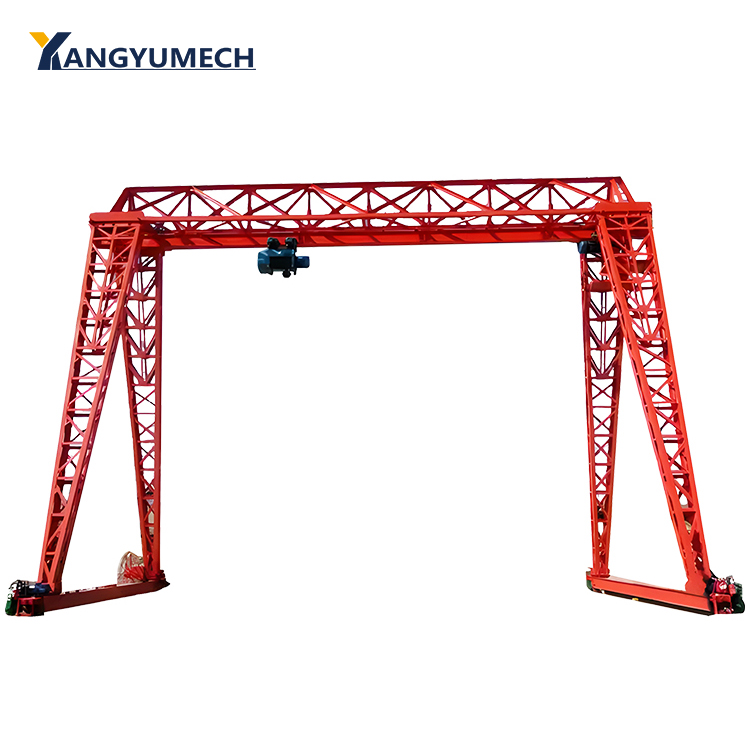Rail Mounted vs. Rubber Tyred Gantry Crane Structural Differences
Gantry cranes are critical in container terminals, intermodal yards, manufacturing facilities, and heavy industrial sites. Among the most common types are Rail Mounted Gantry (RMG) cranes and Rubber Tyred Gantry (RTG) cranes. While their core purpose – lifting and transporting heavy loads – is similar, the structural design of each type is tailored to its mobility, load handling, and operational environment.
Understanding the structural differences between RMG and RTG cranes is essential for making the right investment decision, as it directly impacts performance, maintenance, and cost-effectiveness.

1. Overview of RMG and RTG Cranes
Rail Mounted Gantry (RMG) Crane
Operates on fixed steel rails embedded in the ground.
Designed for precise, repetitive operations over a fixed route, typically in ports, rail yards, and container storage areas.
Known for high lifting capacity, large span, and excellent positioning accuracy.
Rubber Tyred Gantry (RTG) Crane
Moves on large rubber tyres, allowing mobility across different sections of a yard.
Used in container terminals and industrial facilities where flexibility is required to access multiple stacking areas.
Favored for locations without fixed rail infrastructure.
While these operational distinctions are well known, the structural design differences between RMG and RTG cranes are often less discussed – yet they are crucial for performance and reliability.
2. Structural Design of Rail Mounted Gantry Cranes
RMG cranes are designed for rigidity, stability, and precision rather than mobility. Key structural features include:
2.1. Supporting Legs and Crossbeam
Long and Rigid Span: Rail mounted gantry crane for sale often have a longer main girder span to cover wide stacking areas or multiple railway tracks.
Tall Portal Frame: The legs are tall and robust, enabling high stacking heights while resisting lateral deflection under heavy loads.
Fixed Geometry: The structure is optimized for movement in a straight line, with no need to accommodate turning forces.
2.2. Wheel Assemblies and Rail Interface
Steel Wheels: Small, flanged steel wheels roll directly on crane rails, providing minimal rolling resistance.
Fixed Axle Alignment: Since RMG cranes do not steer, wheel alignment is rigid, reducing structural complexity in the lower frame.
Rail Guidance: Guide mechanisms ensure precise movement along the rail, so the structure can be designed with tighter tolerances.
2.3. Bracing and Stability
Diagonal Bracing: Heavy cross-bracing between the legs resists wind loads and seismic forces.
Low Center of Gravity: Structural weight is concentrated low to the ground for stability.
Minimal Flexibility: RMG designs prioritize rigidity, as the travel path is predetermined.
3. Structural Design of Rubber Tyred Gantry Cranes
RTG cranes are designed for mobility, adaptability, and self-propelled operation. This requires different structural considerations:
3.1. Frame Flexibility
More Compact Span Options: RTG cranes typically have a smaller span compared to RMG cranes to maintain maneuverability.
Flexible Frame Joints: Certain structural components may allow controlled flexibility to accommodate uneven ground surfaces.
Shorter Leg Extensions: Legs are still tall enough for stacking, but the height-to-width ratio is balanced for mobility stability.
3.2. Tyre and Steering System Integration
Large Pneumatic Tyres: The crane structure must support heavy-duty rubber tyres capable of carrying full load while absorbing ground irregularities.
Steering Load Accommodation: The lower frame is reinforced to handle torsional forces from steering and turning.
Suspension Interfaces: Some RTGs integrate suspension systems or oscillating bogies, affecting the leg and crossbeam connections.
3.3. Weight Distribution
Balanced for Mobility: The weight is more evenly distributed to prevent tipping during turns.
Higher Center of Gravity Management: RTGs often carry heavier structural weight higher up, so stability under dynamic motion is a key consideration.
4. Major Structural Differences Between RMG and RTG Cranes
Aspect RMG Crane Structure RTG Crane Structure
Mobility Requirement Fixed rail track, no steering forces Full mobility, must handle steering and turning loads
Span Length Often longer to cover multiple tracks or wider stacks Shorter for ease of maneuvering
Wheel Type Small flanged steel wheels Large rubber tyres
Lower Frame Reinforcement Less torsional reinforcement needed Heavy torsional reinforcement for turning
Bracing Design Rigid cross-bracing for stability Reinforced joints allowing controlled flexibility
Weight Distribution Concentrated low to reduce deflection Balanced to maintain stability in motion
Structural Tolerance Tight tolerances due to rail guidance More tolerance for uneven ground and manoeuvring forces
5. Impact on Operational Performance
5.1. Precision vs. Flexibility
RMG: Structural rigidity ensures extremely precise positioning, essential in rail container handling where track alignment is fixed.
RTG: Mobility-focused design allows the crane to adapt to varying container yard layouts, though with slightly less positioning accuracy.
5.2. Maintenance Implications
RMG: Structural wear is minimal due to smooth rail operation, but rail alignment must be maintained.
RTG: Tyres and steering components experience more wear, requiring reinforced lower structures and more frequent inspections.
5.3. Installation and Infrastructure
RMG: Requires fixed rail installation, which dictates the crane’s operational path.
RTG: Requires no rails but demands a structurally capable frame to withstand uneven surfaces and dynamic movements.
6. Structural Considerations for Specific Applications
Port and Terminal Use
RMGs are ideal for high-volume, fixed-lane container handling with large spans and tall frames.
RTGs excel in flexible stacking yards where layouts change or space is constrained.
Industrial and Manufacturing Sites
RMGs are suitable for repetitive, precise heavy lifting over rail lines or production lines.
RTGs can serve multiple loading zones within the same facility without structural relocation.
7. Future Trends in Structural Design
The structural gap between RMG and RTG cranes is narrowing due to:
Hybrid Solutions: Cranes that can operate on both rails and tyres.
Lightweight High-Strength Materials: Reducing weight while maintaining structural strength.
Automation Integration: Structures designed to accommodate automated guidance and anti-sway systems.
Modular Frames: Allowing partial disassembly for easier transport and reconfiguration.
8. Conclusion
While both Rail Mounted Gantry cranes and Rubber Tyred Gantry cranes share the same core purpose, their structural designs diverge to meet different operational needs.
RMG cranes feature rigid, long-span structures optimized for precision and stability along fixed tracks.
RTG cranes prioritize a reinforced, flexible frame capable of handling steering forces and uneven surfaces, enabling unrestricted mobility.
Choosing between the two involves balancing structural capabilities, site infrastructure, and operational priorities. Understanding these structural differences ensures you invest in the crane type best suited to your environment — whether that’s the uncompromising precision of an RMG or the versatile mobility of an RTG.


